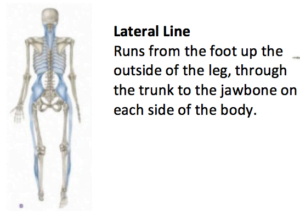Our body’s ability to move is something we rely on every day, from simple tasks such as sitting up in bed each morning, carrying grocery bags, or running to make your morning train to work. But have you ever considered what’s happening under the skin that allows us to complete day-to-day tasks or do a workout at the gym?
Joints and muscles are connected and work together in ways you would never expect – for example, did you know:
– The soles of your feet are connected to your eyebrows;
– Your pelvic floor function can be affected by tightness in your calves;
– Activating muscles around your left shoulder blade can help your right-side glutes get stronger?
The muscles in the body are interconnected by tissue to form long lines within the body referred to as Anatomy Trains (as described by Thomas Myers in his book ‘Anatomy Trains’), and a tightness or dysfunction in any part of this train can cause pain, weakness or dysfunction in any other part of the train. Understanding what muscles are connected can help when trying to relieve pain or muscle tightness, correct posture and increase body function and strength. Check out the image to see the major Anatomy Trains in the body – you may be surprised by some of the connections! (source: Anatomy Trains, Thomas M. Myers, 2013)





Let me demonstrate just how complex some of these connections are… Consider the ‘Superficial Backline’, which runs from the sole of your foot up the back of your legs (calves and hamstrings), links to your pelvic floor, runs up your spine, over the top of your head to your eyebrows. Remembering that a problem in one part of the train can cause pain or dysfunction in any other part of the train, can you now see how having an overly tight muscle in the arch of your foot could cause you to get a headache?
Recently I have been trying to strengthen my glutes as they struggle to activate properly when I exercise, which can put unnecessary pressure on my thighs and lower back. To help strengthen my glutes I have been doing single-leg squats among other exercises, but during these squats I am also using my back muscles – When I squat on my right leg I am holding on to a pole for support with my left hand and actively squeezing my back muscles on the left side. May sound strange, but through the ‘Spiral Line’ you can see those muscles are all connected – activate one and you will help activate all the others in the train!
When you are having pain or difficulty with one part of your body it is important to look not only at the muscles or joint in that area, we have to consider just how interconnected our muscles are – they work in synergy!
The feet are connected to almost every other part of your body, so check out our Focus on Feet post to find out more on just how much impact the feet have on the rest of your body.







